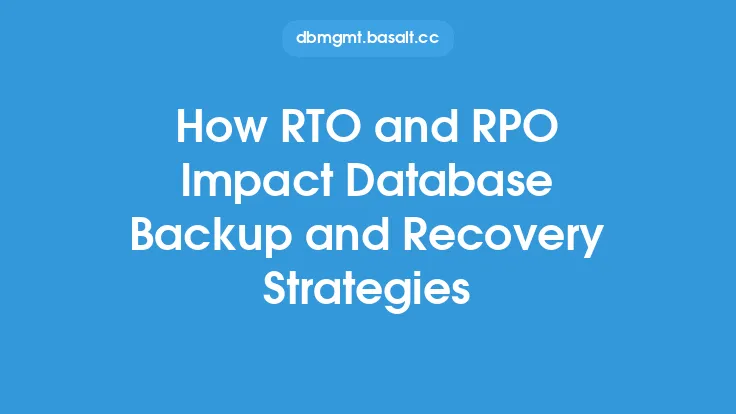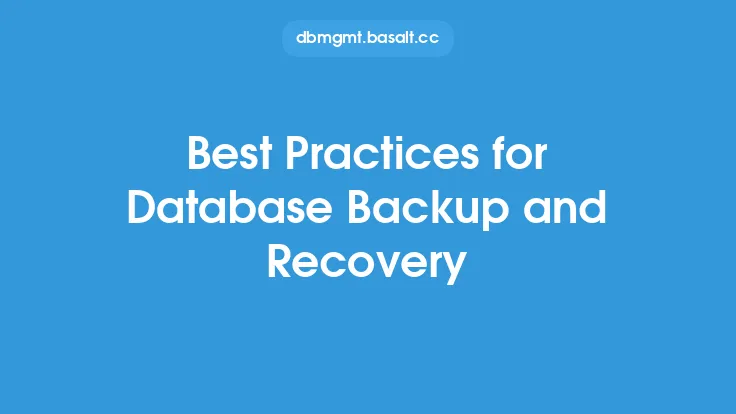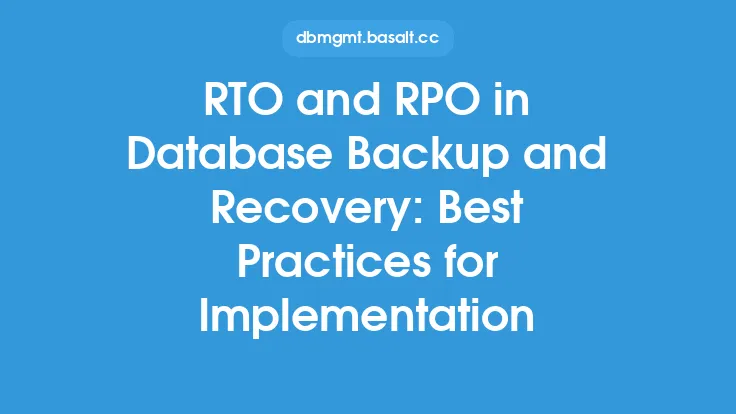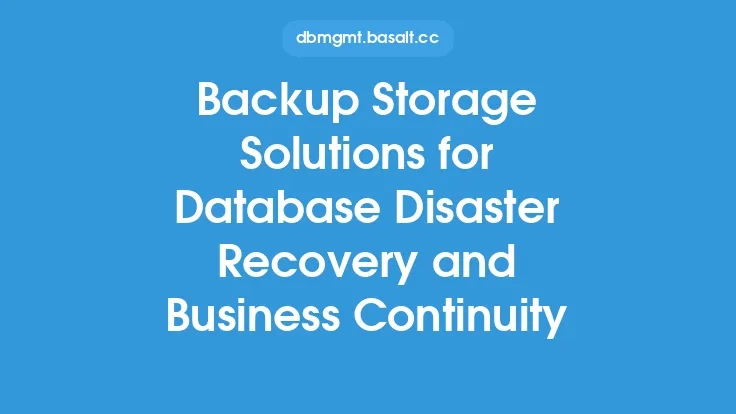Database backup and recovery are crucial components of a comprehensive database management strategy. A well-planned backup and recovery approach ensures that an organization's critical data is protected against loss, corruption, or unauthorized access, and can be quickly restored in the event of a disaster or system failure. In this article, we will delve into the world of database backup and recovery strategies, exploring the different types of backups, recovery techniques, and best practices for ensuring the integrity and availability of database systems.
Introduction to Database Backup Types
There are several types of database backups, each serving a specific purpose and offering varying levels of data protection. The most common types of backups include:
- Full backups: A complete copy of the database, including all data, indexes, and system files.
- Incremental backups: A backup of the changes made to the database since the last full or incremental backup.
- Differential backups: A backup of the changes made to the database since the last full backup.
- Transaction log backups: A backup of the transaction log files, which contain a record of all changes made to the database.
- Snapshot backups: A backup of the database at a specific point in time, often used for quick recovery and testing purposes.
Database Recovery Techniques
Database recovery involves restoring the database to a consistent state after a failure or data loss. There are several recovery techniques, including:
- Point-in-time recovery: Recovering the database to a specific point in time, often used to recover from user errors or data corruption.
- Crash recovery: Recovering the database after a system failure, often used to restore the database to a consistent state.
- Media recovery: Recovering the database from backup media, often used to restore the database after a disk failure or data loss.
- Database replication: Maintaining multiple copies of the database, often used to ensure high availability and disaster recovery.
Backup and Recovery Tools
There are several backup and recovery tools available, both commercial and open-source. Some popular tools include:
- Database management system (DBMS) built-in tools: Most DBMSs offer built-in backup and recovery tools, such as SQL Server's SQL Server Management Studio and Oracle's Recovery Manager.
- Third-party backup and recovery software: Tools like Veritas NetBackup, Commvault, and Veeam offer advanced backup and recovery features, including automation, compression, and encryption.
- Open-source tools: Tools like MySQL's mysqldump and PostgreSQL's pg_dump offer free and flexible backup and recovery options.
Best Practices for Database Backup and Recovery
To ensure the integrity and availability of database systems, it is essential to follow best practices for database backup and recovery. Some key best practices include:
- Developing a comprehensive backup and recovery strategy: Define the types of backups, frequency, and retention period based on business requirements and regulatory compliance.
- Automating backup and recovery processes: Use scripts, jobs, or third-party tools to automate backup and recovery tasks, reducing manual errors and ensuring consistency.
- Testing backup and recovery processes: Regularly test backup and recovery processes to ensure they are working correctly and can be relied upon in the event of a disaster.
- Storing backups securely: Store backups in a secure location, such as an offsite data center or cloud storage, to protect against data loss and unauthorized access.
- Monitoring backup and recovery processes: Continuously monitor backup and recovery processes to detect any issues or errors, and take corrective action promptly.
Database Backup and Recovery Challenges
Despite the importance of database backup and recovery, there are several challenges that organizations face. Some common challenges include:
- Data growth: The rapid growth of data can make it difficult to manage backups and recoveries, particularly in large and complex databases.
- Complexity: Database systems can be complex, with multiple components and dependencies, making it challenging to develop and implement effective backup and recovery strategies.
- Regulatory compliance: Organizations must comply with regulatory requirements, such as data retention and protection, which can add complexity to backup and recovery processes.
- Resource constraints: Backup and recovery processes can be resource-intensive, requiring significant storage, network, and compute resources.
Future of Database Backup and Recovery
The future of database backup and recovery is likely to be shaped by emerging technologies, such as cloud computing, artificial intelligence, and machine learning. Some potential trends and innovations include:
- Cloud-based backup and recovery: Cloud storage and compute resources offer a scalable and flexible platform for backup and recovery, reducing the need for on-premises infrastructure.
- Automated backup and recovery: AI and machine learning can be used to automate backup and recovery processes, reducing manual errors and improving efficiency.
- Real-time backup and recovery: Emerging technologies, such as change data capture and streaming replication, enable real-time backup and recovery, reducing downtime and improving availability.
- Data protection as a service: Cloud-based data protection services offer a convenient and scalable way to manage backup and recovery, reducing the need for on-premises expertise and infrastructure.
Conclusion
Database backup and recovery are critical components of a comprehensive database management strategy. By understanding the different types of backups, recovery techniques, and best practices, organizations can ensure the integrity and availability of their database systems. As database systems continue to evolve and grow, it is essential to stay up-to-date with emerging trends and technologies, such as cloud computing, AI, and machine learning, to ensure that backup and recovery processes remain effective and efficient. By prioritizing database backup and recovery, organizations can protect their critical data assets and ensure business continuity in the face of disaster or system failure.





